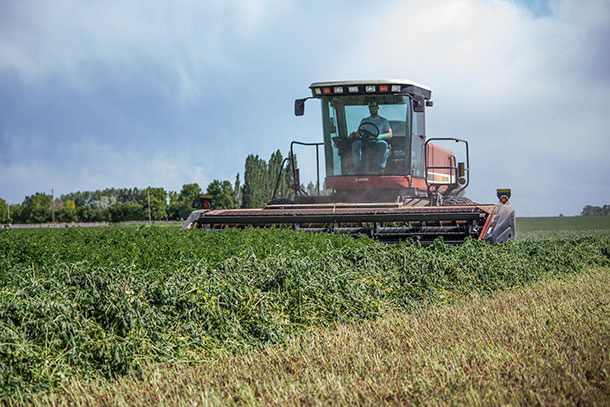To ensure that the crop does not become stressed it’s extremely important, during hot summer months, to refill the soil moisture profile immediately after bale removal to promote regrowth and avoid the risk of stress. However, irrigating with a drip system means there’s added potential for finding extra opportunities to water just before swathing and right after harvest.
Between the time when summer cuttings are being readied for harvest to removing the bales is one of the most critical periods to safeguard the crop’s overall health. In order to protect the crop’s quality, growers need to carefully monitor alfalfa for signs of stress and get water back onto the fields quickly and efficiently.
When growers pull the last bale off, they want to start the water as quickly as possible. With drip we can apply water rapidly since we’re covering the whole field versus irrigating a typical 40 acres with 14 border checks that can take seven to 10 days to get across the field.
To achieve a good, deep irrigation on heavy soils, it’s vital to let the water run for 24 hours, then turn it off for 24 hours to allow capillary action to move it out into the soil profile. After the rest period, fields should be irrigated again for another 24 hours so that about 2 inches of water has been applied. For alfalfa grown on lighter-textured soils, these fields can be watered 12 hours on, 12 off, then another 12 hours on to achieve similar results.
Following the deep-filling irrigation, it is important to verify moisture level depths at 12 and 24 inches vertically while also checking that there are adequate soil moisture levels between the laterals.
Growers need to make sure they have irrigated long enough to adequately fill the soil moisture profile to avoid loss of production. Drip allows growers to water closer to harvest and soon after as long as the surface ground stays dry for machinery to move through the fields.
Published in 2008 by the University of California Alfalfa Workgroup, the Irrigated Alfalfa Management for Mediterranean and Desert Zones book says that irrigating close to harvest and prior to removing the bales lessens the risk of the crop getting close to a permanent wilting point.
In chapter seven, the authors state, “One advantage of drip irrigation of alfalfa is that irrigations could continue during the harvest period as long as no wetting of the soil surface occurs.”
The authors focused much of their attention on other irrigation methods used by growers following harvest – sprinkler, flood and using a center-pivot – since drip had little application on alfalfa prior to its publication. However, the authors had the foresight to bring up key aspects about using drip on this crop, which offers insight into the growing acceptance of the benefits of alfalfa grown on drip.
We advise that anyone growing alfalfa should keep this book handy as it is the ultimate reference book to answer any questions or concerns growers may encounter.
To ensure, as the authors say, that no wetting of the soil surface occurs, growers need to continually scout for any leaks and diligently defend against rodents.
Growers can irrigate one to two days closer to their harvest window, if they follow those guidelines and watch for any signs of surface moisture so leaks can be addressed quickly.
Drip irrigation during curing would create a stress-free environment, but only if there’s a 100 percent guarantee there were no rodents in the field. Since it’s likely few growers could make that claim, the next best way to lessen plant stress is to put water on all at one time, which is what drip irrigation can achieve, over other methods, in an efficient and timely manner. ![]()
Todd Rinkenberger is the director of sales, West agriculture and strategic projects, for Netafim USA. He is a 21-year veteran of the agricultural irrigation industry and has a background in crop and dairy production. Email Todd Rinkenberger.
PHOTO: Growers are anxious from the moment cutting starts to get water back on the alfalfa fields as quickly as possible. Monitoring the soil moisture profile is critical to subsequent production. Photo by Lynn Jaynes.














